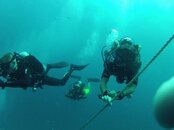I'm confused.
How is a BP/W any more difficult that a jacket.
Once it's on, the controls are the same.
Once you're in the water the air is going to the highest point in either style.
I've used a BP/W, and yes, they're good, but I do think there is a lot of overblown hype.
I don't use one because a lot of my diving is overseas, and I tend to rent a BCD, and BP/W is hard to come by.
A good diver is a good diver regardless of the equipment they're using.
Or am I missing something obvious?
Gear doesn't beat skill.
My understanding is that they're not just putting new divers into a BP/W but teaching them trim, which is hard to achieve in a jacket-style BC.





